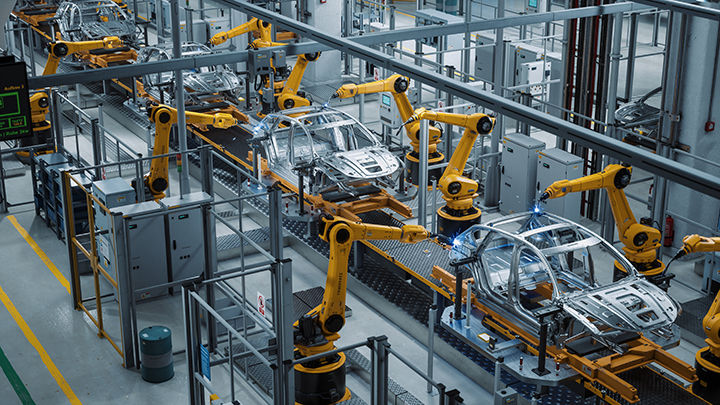The third post in our Great Power Competition (GPC) series takes a closer look at factors that make China's electric vehicle (EV) sector one of the more formidable global players. Domestically, the focus on EVs is part of a strategic shift away from the languishing property market and towards high-end manufacturing sectors in an effort to drive the country's future economic growth. At the same time, situated within the context of geopolitical tensions and trade wars, the strength of China's EV market continues to generate international headlines. Our recent tour of an EV factory in China sheds light on the country's delicate balancing act, galvanizing resources to support the development of a cutting-edge sector for the sake of its domestic economy while navigating growing international concern over unfair competition.1
EVs' Role in China's Growth Strategy
For more than a decade, China has made technological innovation in manufacturing part of a strategic push to promote industrial transformation in traditional manufacturing's inefficient, labor-intensive operating model. Its state-led strategic plan, "Made in China 2025" (MiC25), has stressed investment in innovation-driven manufacturing, with an emphasis on quality, green development, the optimization of industry structure, and the cultivation of human talent.2 In recent years, this top-down decision-making has given enterprises more room to invest in research and development (R&D). Consequently, since 2018, public and private Chinese enterprises have made significant investments in high-end EV manufacturing (Fig. 1; inclusive of R&D).
Figure 1
Share of Total Cumulative Venture Captial Investment in EV Technology Areas by Country or Region, 2018-2023*
Source: IEA analysis based on Cleantech Group i3 database as of March 2024.
*Includes both early- and growth-stage deals. The country or region is determined based on company headquarters and not the origin of investors. “Europe” includes European Union countries, Norway, Switzerland and the United Kingdom.
A New Type of Chinese Automaker
At its core, high-end EV manufacturing in China is built around the principles of MiC25 that emphasize "intelligent" production—i.e., applying technological tools in an attempt to create a fully-integrated production ecosystem.
ZEEKR Intelligent Technology Co., Ltd. (ZEEKR) is the EV subsidiary of Geely Automobile Holdings Ltd. and one of China's more prominent EV brands. Founded in March 2021, ZEEKR has a "co-creation and co-investment" business philosophy that works with global "ecological" partners.3 In 2021 and 2023, ZEEKR completed financing deals for $500 million and $750 million, respectively, to develop products and technologies, etc.4 Investors included entities such as Ningbo Tongshang Fund Management, Contemporary Amperex Technology Co. Limited (CATL),5 Yuexiu Industrial Fund, and Quzhou Xin'an Intelligent Manufacturing Fund. These suppliers specialize in various fields—e.g., in intelligent driving, batteries, materials, and advanced equipment manufacturing.
We visited ZEEKR's flagship factory, located in the Zhejiang province, for a glimpse into its operations.
Visit to ZEEKR's "Intelligent" EV Factory
ZEEKR's EV factory was put in operation in 2021 to manufacture its flagship EV model, ZEEKR 001 - a premium vehicle said to have more than 1.57 million customized configurations, targeting users who might want to switch from established European entry-level luxury brands. To accommodate the model's production requirements, the factory's design incorporates agile, interconnected manufacturing and intralogistics systems that emphasize the accuracy and timeliness of material distribution.
The day we visited, 700 workers were on the factory floor, mostly engaged in quality inspection. Most of the heavy assembly was handled by autonomous mobile robots (AMRs). In total, 300 AMRs were deployed in assembly, welding, and painting workshops. These AMRs were managed by a robot control system (RCS) which included flexible route planning functionality to avoid "traffic jams" and control material handling. This was purported to have improved labor efficiency by at least 20% and energy utilization rate by 15%.
Operating at a capacity utilization rate between 50% and 60%, ZEEKR's production stood at 480 vehicles per day (~200,000 vehicles per year).6 While capacity utilization was in-line with the average rate for China's automotive sector, it has declined from a high of ~78% a few years ago. For reference, Tesla produced 412,376 Model 3/ Model Y vehicles in Q1 of this year and lists its annual installed capacity for all Model 3/ Model Y vehicles at its Fremont, CA and Shanghai factories at more than 550,000 and 950,000, respectively.7
Changing Industry Structure through Public & Private Coordination
The high degree of coordination and integration amongst private enterprises, the local government, and state-owned enterprises supports the optimization of the EV sector. In ZEEKR's case, the factory was 5G-enabled throughout as it was built in cooperation with China Unicom Zhejiang, a state-owned telecommunications provider. In addition, Hikrobot, a subsidiary of the world's largest provider of video surveillance equipment (Hikvision), supplied the RCS managing the factory's AMRs.
Furthermore, the factory broke ground in 2018 and was commissioned within a very short timeframe. In fact, product deliveries began just three years after it broke ground. This was facilitated by a strategic agreement signed with the local government of Ningbo city, which cemented Ningbo as the locale for green technology and EV manufacturing.
On the demand side, central government subsidies to EV buyers and the loosening of license plate restrictions in key cities like Beijing smoothed the path for EV producers to get their product to market. These subsidies are also available to western EV makers that have set up shop in China, e.g. - Tesla, resulting in the country being one of the most competitive EV markets in the world.
China's Participation in the Global EV Market
Bolstered by public and private investments, China became the world's largest EV production base with ~6.7 million units made, which accounted for 58% of total global sales in 2022. By 2023, China's trade balance in the auto sector rose sharply by more than $30 billion, largely boosted by exports in motor vehicles - which had previously been negative.8
Currently, Chinese producers account for close to 20% of EV sales in Europe with the figure poised to reach 25% by the end of 2024 (Fig. 2 indicates the acceleration in exports). The sharp rise in Chinese EV exports has elicited cries of unfair competition from the U.S. and the EU as prices are often lower due to the lower cost of financing and indirect government subsidies into the sector. Indeed, a major Japanese automaker cut its annual profit forecast by 20% for the current year amid its plans to invest in artificial intelligence and its EV segment in order to better compete with China.
Figure 2
Chinese Battery Electric Vehicle Exports by Region ($B)
Source: Atlantic Council
ZEEKR's Planned Expansion & IPO
Located near neighboring ports and logistics facilities for ease of exports, ZEEKR plans to expand into six European markets in 2024 and is targeting another 38 markets across Southeast Asia and the Middle East. To date, the majority of ZEEKR's output is still being funneled into the domestic market.
To help finance its expansion, ZEEKR (ZK) went public on the NASDAQ in early May of this year. The timeframe for ZEEKR's IPO was three years compared to seven years for Tesla. Post visit, we learned that ZEEKR's valuation was sharply reduced by ~50% in its last funding round. This was likely due to concerns over the intense price competition in the global EV market as well as additional restrictions and tariffs to be levied on Chinese producers. For example, the U.S. has imposed restrictions on the export of lithography machines for chipmaking to China through third-party channels.9 In addition, following the completion of an anti-subsidy investigation that started in the fall of last year, the European Commission (EC) announced on June 18th that it would impose additional tariffs on EV imports from China, effective July 4th. ZEEKR's parent company, Geely, was among the automakers singled out by the EC. Tariffs ranged from 17.4% to 38.1%. Companies that did not cooperate would be hit with a 38.1% tariff.
A Broader Look at the EV Ecosystem
Despite being perceived as a threat to automakers in the developed world, the EV ecosystem in China is still reliant on imports. To illustrate, ZEEKR's factory imports ranged from high-end leather substitutes created by Italian fabric maker, Alcantara, to basic semi-conductor chips from Israel that power the operating systems of the EVs.
With that stated, the major cost component of EV manufacturing remains the battery, an arena where China commands a competitive advantage, given the dominance of the home-grown global battery giant CATL. Batteries are responsible for up to 40% of the cost of making an EV. To build out its EV ecosystem, China has invested heavily in bringing the previously less favored lithium iron phosphate battery (LFP) up-to-date in energy performance, thus lowering production costs. From a trading perspective, the U.S., in particular, is heavily dependent on China for lithium batteries, with a dependence ratio of 70.5% as of 2023. In addition, further up the supply chain, China also controls most of the world's refinery capacity for critical materials like cobalt, nickel sulfate, lithium hydroxide, and graphite.
Conclusion
China has been able to make technological leaps within the EV sector in just a few years. Our visit demonstrated just how effectively the government can marshal public and private resources to support targeted economic revitalization. While the EV sector may provide a promising blueprint on how to implement reforms that promote high-quality production and Chinese modernization, the country still has more to do to stimulate the economy long-term - e.g., replacing jobs lost in the thorny property sector and encouraging consumer spending.
Nevertheless, it is difficult for other countries to replicate China's highly integrated supply chain and logistics channels in the EV sector. As noted in our U.S.-China Competition Through Four Lenses blog, a key objective of MiC25 is to dominate advanced technologies of the future. In other words, through substantive investments and coordination, the government has sought to make prioritized industries more efficient and integrated. Potentially, this could help to enable producers to occupy the highest positions within global production chains.
With that stated, China remains deeply integrated in the global economic system, thus offering the U.S. (and the West) significant leverage. The latest EV-related restrictions and tariffs by the U.S. and EC demonstrate global production interdependence with no clear victors. Although moves by the U.S. and EC indicate a more hawkish approach towards China by current policymakers, China has responded with threats to impose tariffs of its own, which would affect agriculture, aviation, as well as cars with large engines.
1 This trip was organized by a sell-side institution. The descriptions and photos herein are used with permission from the entities involved. The views expressed herein are our own.
2 Source: Made in China 2025 (csis.org). Adopted in 2015.
3 Source: Zhejiang Geely Holding Group Co.
4 Sources: 2023 Press Release by Zhejiang Geely Holding Group Co. and 2021 Press Release by Zhejiang Geely Holding Group Co.
5 A Chinese battery-maker and supplier to Tesla.
6 Ratio of production to past investment(s). As of May 2024, Germany’s capacity utilization rate hovered around 80% in the auto sector.
7 Tesla Q1 2024 Update. "Installed capacity" refers to the maximum productive capacity according to the manufacturers' specification of machines / equipment.
8 Source: UN Comtrade and UBS estimates.
9 Source: China Daily. New focus boosting global supply chains.
Source(s) of data (unless otherwise noted): PGIM Fixed Income, as of June 28, 2024.
For Professional Investors only. Past performance is not a guarantee or a reliable indicator of future results and an investment could lose value. All investments involve risk, including the possible loss of capital.
PGIM Fixed Income operates primarily through PGIM, Inc., a registered investment adviser under the U.S. Investment Advisers Act of 1940, as amended, and a Prudential Financial, Inc. (“PFI”) company. Registration as a registered investment adviser does not imply a certain level or skill or training. PGIM Fixed Income is headquartered in Newark, New Jersey and also includes the following businesses globally: (i) the public fixed income unit within PGIM Limited, located in London; (ii) PGIM Netherlands B.V., located in Amsterdam; (iii) PGIM Japan Co., Ltd. (“PGIM Japan”), located in Tokyo; (iv) the public fixed income unit within PGIM (Hong Kong) Ltd. located in Hong Kong; and (v) the public fixed income unit within PGIM (Singapore) Pte. Ltd., located in Singapore (“PGIM Singapore”). PFI of the United States is not affiliated in any manner with Prudential plc, incorporated in the United Kingdom or with Prudential Assurance Company, a subsidiary of M&G plc, incorporated in the United Kingdom. Prudential, PGIM, their respective logos, and the Rock symbol are service marks of PFI and its related entities, registered in many jurisdictions worldwide.
These materials are for informational or educational purposes only. The information is not intended as investment advice and is not a recommendation about managing or investing assets. In providing these materials, PGIM is not acting as your fiduciary. PGIM Fixed Income as a general matter provides services to qualified institutions, financial intermediaries and institutional investors. Investors seeking information regarding their particular investment needs should contact their own financial professional.
These materials represent the views and opinions of the author(s) regarding the economic conditions, asset classes, securities, issuers or financial instruments referenced herein. Distribution of this information to any person other than the person to whom it was originally delivered and to such person’s advisers is unauthorized, and any reproduction of these materials, in whole or in part, or the divulgence of any of the contents hereof, without prior consent of PGIM Fixed Income is prohibited. Certain information contained herein has been obtained from sources that PGIM Fixed Income believes to be reliable as of the date presented; however, PGIM Fixed Income cannot guarantee the accuracy of such information, assure its completeness, or warrant such information will not be changed. The information contained herein is current as of the date of issuance (or such earlier date as referenced herein) and is subject to change without notice. PGIM Fixed Income has no obligation to update any or all of such information; nor do we make any express or implied warranties or representations as to the completeness or accuracy.
Any forecasts, estimates and certain information contained herein are based upon proprietary research and should not be interpreted as investment advice, as an offer or solicitation, nor as the purchase or sale of any financial instrument. Forecasts and estimates have certain inherent limitations, and unlike an actual performance record, do not reflect actual trading, liquidity constraints, fee. These materials are not intended as an offer or solicitation with respect to the purchase or sale of any security or other financial instrument or any investment management services and should not be used as the basis for any investment decision. PGIM Fixed Income and its affiliates may make investment decisions that are inconsistent with the recommendations or views expressed herein, including for proprietary accounts of PGIM Fixed Income or its affiliates.
Investing in the bond market is subject to risks, including market, interest rate, issuer, credit, inflation risk, and liquidity risk. The value of most bonds and bond strategies are impacted by changes in interest rates. Bonds and bond strategies with longer durations tend to be more sensitive and volatile than those with shorter durations; bond prices generally fall as interest rates rise, and low interest rate environments increase this risk. Reductions in bond counterparty capacity may contribute to decreased market liquidity and increased price volatility. Bond investments may be worth more or less than the original cost when redeemed. Mortgage- and asset-backed securities may be sensitive to changes in interest rates, subject to early repayment risk, and while generally supported by a government, government agency or private guarantor, there is no assurance that the guarantor will meet its obligations. High yield, lower-rated securities involve greater risk than higher-rated securities; portfolios that invest in them may be subject to greater levels of credit and liquidity risk than portfolios that do not. Investing in foreign-denominated and/or -domiciled securities may involve heightened risk due to currency fluctuations, and economic and political risks, which may be enhanced in emerging markets. Currency rates may fluctuate significantly over short periods of time and may reduce the returns of a portfolio. Commodities contain heightened risk, including market, political, regulatory and natural conditions, and may not be suitable for all investors. Diversification does not ensure against loss.
In the United Kingdom, information is issued by PGIM Limited with registered office: Grand Buildings, 1-3 Strand, Trafalgar Square, London, WC2N 5HR.PGIM Limited is authorised and regulated by the Financial Conduct Authority (“FCA”) of the United Kingdom (Firm Reference Number 193418). In the European Economic Area (“EEA”), information is issued by PGIM Netherlands B.V., an entity authorised by the Autoriteit Financiële Markten (“AFM”) in the Netherlands and operating on the basis of a European passport. In certain EEA countries, information is, where permitted, presented by PGIM Limited in reliance of provisions, exemptions or licenses available to PGIM Limited including those available under temporary permission arrangements following the exit of the United Kingdom from the European Union. These materials are issued by PGIM Limited and/or PGIM Netherlands B.V. to persons who are professional clients as defined under the rules of the FCA and/or to persons who are professional clients as defined in the relevant local implementation of Directive 2014/65/EU (MiFID II). In Switzerland, information is issued by PGIM Limited, London, through its Representative Office in Zurich with registered office: Kappelergasse 14, CH-8001 Zurich, Switzerland. PGIM Limited, London, Representative Office in Zurich is authorised and regulated by the Swiss Financial Market Supervisory Authority FINMA and these materials are issued to persons who are professional or institutional clients within the meaning of Art.4 para 3 and 4 FinSA in Switzerland. In certain countries in Asia-Pacific, information is presented by PGIM (Singapore) Pte. Ltd., a regulated entity with the Monetary Authority of Singapore under a Capital Markets Services License to conduct fund management and an exempt financial adviser. In Japan, information is presented by PGIM Japan Co. Ltd., registered investment adviser with the Japanese Financial Services Agency. In South Korea, information is presented by PGIM, Inc., which is licensed to provide discretionary investment management services directly to South Korean investors. In Hong Kong, information is provided by PGIM (Hong Kong) Limited, a regulated entity with the Securities & Futures Commission in Hong Kong to professional investors as defined in Section 1 of Part 1 of Schedule 1 of the Securities and Futures Ordinance (Cap.571). In Australia, this information is presented by PGIM (Australia) Pty Ltd (“PGIM Australia”) for the general information of its “wholesale” customers (as defined in the Corporations Act 2001). PGIM Australia is a representative of PGIM Limited, which is exempt from the requirement to hold an Australian Financial Services License under the Australian Corporations Act 2001 in respect of financial services. PGIM Limited is exempt by virtue of its regulation by the FCA (Reg: 193418) under the laws of the United Kingdom and the application of ASIC Class Order 03/1099. The laws of the United Kingdom differ from Australian laws. In Canada, pursuant to the international adviser registration exemption in National Instrument 31-103, PGIM, Inc. is informing you that: (1) PGIM, Inc. is not registered in Canada and is advising you in reliance upon an exemption from the adviser registration requirement under National Instrument 31-103; (2) PGIM, Inc.’s jurisdiction of residence is New Jersey, U.S.A.; (3) there may be difficulty enforcing legal rights against PGIM, Inc. because it is resident outside of Canada and all or substantially all of its assets may be situated outside of Canada; and (4) the name and address of the agent for service of process of PGIM, Inc. in the applicable Provinces of Canada are as follows: in Québec: Borden Ladner Gervais LLP, 1000 de La Gauchetière Street West, Suite 900 Montréal, QC H3B 5H4; in British Columbia: Borden Ladner Gervais LLP, 1200 Waterfront Centre, 200 Burrard Street, Vancouver, BC V7X 1T2; in Ontario: Borden Ladner Gervais LLP, 22 Adelaide Street West, Suite 3400, Toronto, ON M5H 4E3; in Nova Scotia: Cox & Palmer, Q.C., 1100 Purdy’s Wharf Tower One, 1959 Upper Water Street, P.O. Box 2380 -Stn Central RPO, Halifax, NS B3J 3E5; in Alberta: Borden Ladner Gervais LLP, 530 Third Avenue S.W., Calgary, AB T2P R3.
© 2024 PFI and its related entities.
2024-5195
Collapse Section









